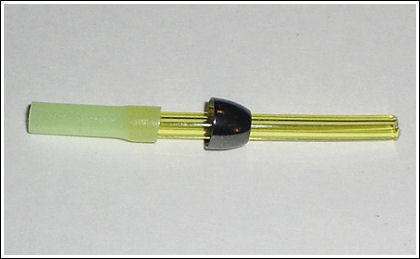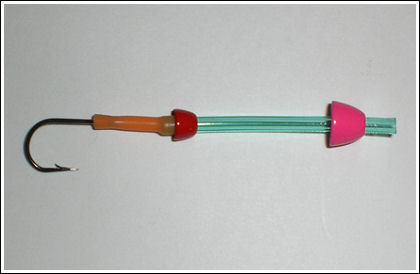|
The Modular
Tube Fly - Part 2
By Benson Adams

Part
two of the Modular Tube Fly series will cover adding and
removing weight to your flies. This is one of my favorite
options in the Modular Tube Fly System and is definitely one
of the most valuable as well. With the option of adding and
removing weight to a tube fly, we can fish the same single
tube fly in different seasons and situations.

Obviously we can't use the
same fly in every situation. With the Modular Tube Fly
System, you can take a fly you fished in a shallow run
during the summer time, add a cone head weight to it, and
fish it through a deeper section of the river. Normally you
would've had to tie the same fly twice, one being weighted
with a cone head, and a second without the cone head, in
order to fish the same style of fly effectively through a
shallow and deep pool. But now in some situations you can
tie just one tube fly, bring a cone head weight with you to
the river, and if you need to, add the cone head weight to
the tube fly. Or if you know in advance that you will be
fishing mostly deep pools, add the weight to the tube fly
before you hit the river, and only remove the weight if
needed.

The first step to using the
interchangeable cone head weights is to tie your Modular
Tube Fly on a tube that closely fits the cone head weight's
interior diameter. It doesn't have to be an exact fit, if
the cone head's inside diameter is a little large then the
tube you are tying on, that is ok. As long as the junction
tubing holds the cone head weight on, your are set. I use a
variety of options when creating this style of a fly. HMH
Hybrid Tubing (pictured above), as well as Canadian Tube Fly
Companies' Flex-Tube (pictured above and below) both work
very well. There is an assortment of different junction
tubing available that will fit on these types of tubes.
Tubeology Junction Tubing works well for bigger sized hooks.
Canadian Tube Fly Company makes a junction tubing that works
great for medium to larger sized hooks.

Pictured above, we have the
backbone of a Modular Tube Fly, with a smaller cone head
weight on the back, and the larger pink cone head positioned
in the front of the pattern. It is very important to tie on
the larger cone head weight in the front of the fly. I
almost always use the larger, heavier cone head in the
front, and a smaller cone head in the back. If you use a
larger cone head in the back, and a smaller cone head in the
front, you will have hook hang down, where the rear of your
tube fly is heavier then the front, causing the fly to swim
at an angle with the hook hanging down in the back. We want
to avoid this scenario whenever possible so that our fly
swims horizontal instead of at an angle.

Now that you have seen how
to add weight to the tube fly on the backbone, we will see
how it works on a finished tube fly (pictured below). I'm
using a pink cone head on the end of this tube fly intruder
so that it stands out a little bit more in the picture,
obviously you can use whatever colors you have available.
This tube fly was tied on a piece HMH Hybrid Tubing, with
Tubeology Junction Tubing to hold the cone head in place.

Pictured below, we have the
smaller sized cone head placed on the end of the tube fly,
with a hook placed in the junction tubing so that you can
see what the finished tube fly will look like. This tube fly
intruder has a heavy cone head weight at the front of the
tube, it is underneath the spun Rhea, Amherst and Ostrich
hurls, making it harder to see.

Finally there is yet
another, very simple option that allows you to add weight to
your tube fly, or any fly for that matter. You can easily
add weight to the front of almost any fly by sliding a cone
head, or bead head weight up the line before you tie the fly
on under it. Pictured below is a fly that was originally
tied for shallow water, but with the addition of a cone head
weight on the front, this same tube fly can now be fished
through a deeper section of the river if needed, by simply
adding a cone head, or bead head weight to the front.

Additionally you could use
this last option to help eliminate hook hang down. Let's say
you are fishing a fly you have recently tied for the first
time and for whatever reason there is more weight on the
back of the fly. Normally the only way you could avoid hook
hang down in this situation would be to swap out the fly.
However to avoid hook hang down without having to completely
swap out flies, you can add a smaller sized cone head weight
on the line in front of the fly. This option won't work for
every application, but you may find yourself in a situation
where it might just do the trick.
By Benson
Adams 2012 ©
www.northwesttubefly.com/
|